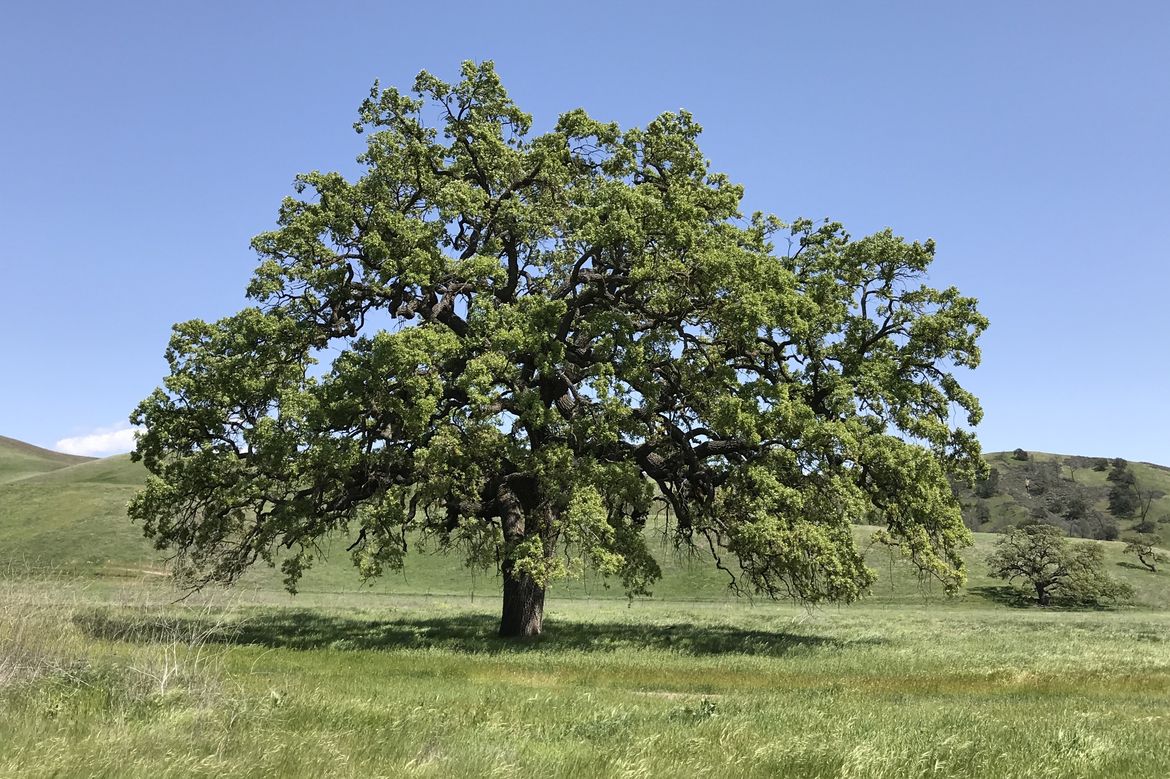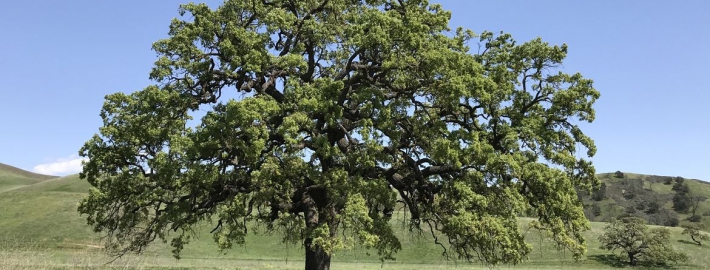One of California’s iconic tree species offers lessons for conservation

The valley oak, the largest oak in California, grows to over 100 feet tall and provides habitat and food for a variety of animals. Photo credit: Victoria Sork/UCLA
With increasing regularity, Californians are witnessing firsthand the destructive power of wildfires. But not everyone sees what happens after the flames die down, when debris is cleared, homes and lives rebuilt — and trees replanted to help nature recover.
New research led by UCLA evolutionary biologist Victoria Sork examines whether the trees being replanted in the wake of California’s fires will be able to survive a climate that is continuing to warm.
The study, which is published in the Proceedings of the Natural Academy of Sciences, focuses on California’s iconic valley oak. The research is among the first to demonstrate the potential of using genomics to inform conservation strategies — essentially giving species an evolutionary boost. The study showed that planting trees that are genetically better suited to higher temperatures makes them more likely to survive and grow to maturity.
“When we think about managing ecosystems under rapidly changing climates, we have to realize trees need to be able to survive past 50 years,” Sork said.
The paper also discovered something surprising: The valley oak, an essential component of many ecosystems in California, is already poorly adapted to its environment — even considering climate conditions in 2019.
“They actually seem to grow better in cooler climates than they’re in right now,” said Luke Browne, a postdoctoral scholar at the UCLA La Kretz Center for California Conservation Science and the study’s lead author. “They might grow better if climates were more like they were 21,000 years ago, during the last ice age.”
During the peak of the last ice age, summer temperatures were about 4 to 5 degrees Celsius colder, and ice covered most of Canada and mountainous areas of the U.S.
In the fields of conservation and land management, it is a common assumption that plants and animals are adapted to their environments — that’s how evolution and natural selection are supposed to work. The new research casts doubt on that assumption.
The study is part of an ongoing project initiated by Sork and Jessica Wright, an expert in conservation genetics at the USDA Forest Service, more than 10 years ago.
Researchers gathered 11,000 seeds from 94 locations throughout the trees’ range, which stretches from the Santa Monica Mountains to the Cascade foothills in the northern part of the state. They grew them to saplings in a greenhouse and planted them in two large experimental gardens, in Chico and Placerville, California. They tracked how well trees from different locations grew, and sequenced the genomes of their mother trees to link genetic information and growth rates.
The researchers then identified which genetic variants would be more likely to thrive as climate change continues to warm California. They predicted that, under predicted future warmer temperatures, trees containing beneficial genetic variations would have 11% higher growth rates than the average for all of the trees in the experiment, and 25% higher growth rates than the trees without the beneficial variations.
Information like that could help the U.S. Forest Service, for example, in its efforts to restore forests with species that have the best chance for long-term survival.
“Studies like this one provide valuable insights that help land managers make informed decisions on reforestation projects,” Wright said. “When planting trees in a particular location, managers have to decide where to collect the acorns.”
By 2070, average temperatures in the state are projected to be up to 4.8 degrees warmer than they were during the mid- to late 20th century.
“That’s going to have consequences for how fast these trees grow,” Browne said. “We’re at a challenging time to figure out the best way to do conservation science. This paper shows one approach we could use that takes advantage of modern genomics.”
The study did not determine why valley oaks are not well adapted to their environment. It might be because the climate has already warmed up so much, the trees’ long lifespans — up to 500 years — or some other, unknown factor.
The valley oak is the largest oak in California; it grows to over 100 feet tall, and has dark green leaves and a deeply grooved trunk. It is considered a foundational species because it provides habitat and food for a variety of animals, including squirrels, birds, deer and insects. In parts of the state, it is one of the only species of tree that exists. Valley oaks provide benefits to humans, too: filtering water and providing shady places to escape the heat.
Although it focuses on the oak, the paper has broader implications for conservation science in a changing climate — especially for species that evolve and adapt slowly. That’s what Sork and Wright were thinking when they initiated the project.
At the time, they hoped to find conservation strategies that could eventually be implemented using genetic information alone — without extensive field experiments.
“Not everyone in the world is going to be able to collect 11,000 seeds and plant them in a common garden,” Sork said.
This article originally appeared in the UCLA Newsroom.




